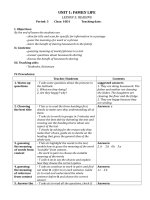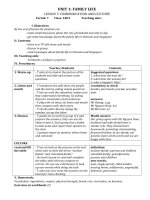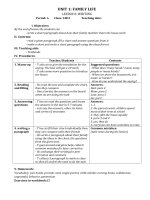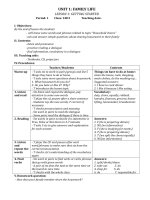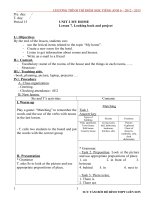Tiếng anh tuần 19-Lớp 6 - Thí điểm
Bạn đang xem bản rút gọn của tài liệu. Xem và tải ngay bản đầy đủ của tài liệu tại đây (167.26 KB, 12 trang )
<span class='text_page_counter'>(1)</span><div class='page_container' data-page=1>
<b>UNIT 7: TELEVISION</b>
<b>I. Objectives. </b>
- By the end of the unit, students will be able to:
<i>+ pronounce correctly the sounds / θ / and / ð</i>/ in isolation and in context.
+ use the lexical items related to television.
+ use conjunctions ( and, but, because ... ) and question words ( where, who, why ... )
+ ask and talk about a favourite TV programme.
+ read a TV schedule and descriptions of famous children’s programmes for specific
information.
+ listen for specific information from a recommended TV schedule.
+ write a short guided passage about one’s TV - watching habits.
- Students will be developed 4 skills: speaking , listening , reading and writing.
- Students will be educated to watch useful programmes, they should spend time on
watching TV suitably and they will like learning English more and more.
<b>II. Teaching aids. </b>
- Textbook, lesson plans, board, chalks, cues, posters, real objects, pictures, computer and
the CD record.
<b>III. Procedure.</b>
Lesson 1: Getting started
Lesson 2: A closer look 1
Lesson 3: A closer look 2
Lesson 4: Communication
Lesson 5: Skills 1
Lesson 6: Skills 2
Lesson 7: Looking back + Project
<b>---Date of preparing: 23/12/2017 Period: 55</b>
<b>UNIT 7 : TELEVISION</b>
<b>LESSON 1 : GETTING STARTED ( P. 6 - 7 )</b>
<b>A.OBJECTIVES: </b>
<i><b>1.Knowledge: - By the end of this lesson, students will be able to listen and read the </b></i>
dialogue between Phong and Hung to understand the details then do some more tasks to
understand more about television.
+ Vocabulary: stupid, entertaining, educational, schedule, comedy, channel.
+ Grammar:
<i><b>2. Skills: practice and develop listening, reading and speaking skills .</b></i>
<i><b>3.Attitude: educate students should spend time on watching TV suitably and they will be </b></i>
interested in learning English more.
<i><b>4.Competence: Ss can self study</b></i>
<b>B.TEACHING AIDS: .</b>
- Textbook, teacher’s book, lesson plan, board , chalks, pictures, posters, stereo and the
CD record,computer,TV.
</div>
<span class='text_page_counter'>(2)</span><div class='page_container' data-page=2>
Chatting, Rub out and remember, Prequestions, Comprehension questions, Grids, Pair
-speaking, Matching, Gap - fill.
<b>D. CONTENTS: </b>
<i><b>I.Oganization: (1 minute)</b></i>
<b>Class</b> <b>Date of teaching</b> <b>Absent students</b>
<b>6B</b>
<i><b>II. Revision / Warmer: (5 minutes)</b></i>
<i><b>* Chatting</b></i>
- T asks Ss some questions
Do you have a TV at home?
Do you usually watch TV?
Which programmes do you watch?
Do you like watching TV?
Who do you usually watch TV with?
- Ss answer freely.
<i><b>III. New lesson: (37 minutes)</b></i>
<i><b>Step1: Pre-reading (12 minutes)</b></i>
<i><b>* Vocabulary:</b></i>
- stupid (adj): đần độn, ngớ ngẩn (examplanation)
- entertaining (adj) : có tính chất giải trí (example)
- educational (adj): có tính giáo dục (example)
- schedule (n): chương trình, lịch trình (realia)
- comedy (n): phim hài (example)
- channel (n): kênh (example)
<i><b> => Checking vocabulary: Rub out and remember</b></i>
<i><b>* Pre - questions</b></i>
+ Set the scene:
- T shows the picture in the textbook P. 6 then asks Ss some questions.
T: Who are they ? Ss: Phong and Hung
What are they talking about? TV
- Ss answer freely.
- T says: Yes, You are going to listen and read the conversation between Phong and
Hung, talking about television.
- T writres two questions on the board.
1. Which channel are they talking about?
2. Who are they talking about?
- T runs through the question.
- T asks Ss to guess the answer.
- T models. VTV3
- Ss guess individually then compare with their partners.
- T gets Ss’ predictions.
<i><b>Step2: While – reading (15 minutes)</b></i>
<i><b>* Activity 1: Listen and read then check:</b></i>
</div>
<span class='text_page_counter'>(3)</span><div class='page_container' data-page=3>
- T gives the instructions: You look at the dialogue then listen to the tape and check your
prediction.
- T turns on the tape twice.
- Ss listen and read.
- T calls two good students to read again the dialogues.
- T asks the others to correct.
<i><b>- T corrects Ss' mistakes. </b></i>
- T gives the instructions: Read again the dialogue and check again your prediction.
- T models one.
1. VTV3
- T checks Ss’ understanding.
- Ss do individually then they compare with their partners.
- T gets Ss’ answers
- T corrects,
<i><b>+ Answer key:</b></i>
1. VTV 3
2. Mr Bean, Tom and Jerry
<i><b>* Activity 2: Comprehension questions ( Part 1 a p. 7)</b></i>
- T shows the poster with 5 questions on the board.
1. What is Hung’s favourite TV programme ?
<i> 2. What channel is Laughing out Loud on ?</i>
<i> 3. Are Laughing out Loud and Mr Bean on the same time?</i>
4. Why doesn’t Phong like Mr Bean?
5. What does Phong say about Tom?
- T runs through the poster.
- T gives the instructions: Read again the dialogue then answer the questions. You give
short answers only.
- T models the first one.
<i> 1. Laughing out Loud </i>
- T checks Ss’ understanding.
- Ss answer the questions individually then compare with their partners.
- T calls one by one student to give the answers.
- T corrects.
<i><b>+ Answer key:</b></i>
<i> 1. Laughing out Loud </i>
2. VTV3
3. No, they aren’t.
4. Because he is awful
5. Tom is stupid but fun.
<i><b>* Activity 3: Grids ( Part 1 b p. 7 )</b></i>
- T draws the table on the board then runs through.
Character Adjectives to describe each
</div>
<span class='text_page_counter'>(4)</span><div class='page_container' data-page=4>
Mr bean funny, ...
Tom
Jerry
- T gives the instructions: Read again the dialogue tthen find adjectives to describe each
character.
- T models one.
- T checks Ss’ understanding.
- Ss work indilvidually in about 1 minutes then they compare with their partners.
- T gets Ss’ answers.
- T and Ss corrects.
<i><b>+ Answer keys: </b></i>
Character Adjectives to describe each
character.
Mr bean funny, awful
Tom stupid, funny
Jerry Intelligent
<i><b>* Activity 4: (Part 1 c p. 7) </b></i>
<i><b>* Pair - speaking </b></i>
- T shows the list of the adjectives then runs through.
popular long educational
boring funny good
entertaining live
- T gives the instructions: Which adjectives can you use to describe a TV programme you
have watched? What programme is it?
- T models.
Cartoon programme is funny.
- T checks Ss’ understanding.
- Ss work in pairs and gives their ideas.
- T walks around to see and help Ss.
- T calls some students to give their ideas.
- T and others Ss give comments.
<i><b>Step 3: Post – reading (10 minutes)</b></i>
<i><b>* Matching. ( Part 2 p. 7)</b></i>
- T shows the words and the pictures in the text book part 2 p. 7 then runs through.
a. game show d. national television
b. local television e. comedy
c. animal programme f. news programme
</div>
<span class='text_page_counter'>(5)</span><div class='page_container' data-page=5>
- T models one. 1 - d.
- T checks Ss’ understanding.
- Ss do individually then compare with their partners.
- T gets Ss’ answers then corrects.
<i><b>+ Answer key:</b></i>
1- d; 2- f ; 3 - b; 4 - e; 5 - a; 6 - c
<i><b>* Gap - fill.</b></i>
- T hangs the poster which has the contents of part 3 p. 7 on the board then runs through.
- T gives the instructions: Use suitable words to complete the sentences.
- T models the first one.
1. national
- T checks Ss’ understanding.
- Ss work with their partners in their tables in about 2 minutes.
- T gets Ss’ answers by dividing the class into 2 groups. One by one student from each
group comes to the board and writes the answer.
- T controls, corrects, gives marks then praises the winner.
<i><b>+ Answer key: </b></i>
1. national 4. competition.
2. comedy 5. Cartoons
3. channels 6. educational
<i><b>IV. Summary: (1 minute)</b></i>
- T asks one student to repeat the main contents of the lesson.
<i><b>V. Homework: (1 minute)</b></i>
- Practice the dialogue, learn by heart vocabulary.
- Finish part 3 in the text book p. 7.
+ T asks Ss to write down two things that he / she likes about television and two
things that he / she doesn’t like about it. Then they shares their ideas to their classmates.
+ T models: 1. Some programmes are boring.
2. There are many channels.
+ T checks Ss’ understanding.
- Do the exercises in the work book: 1, 2, 3 and 4 in part B p. 4 - 5.
- Prepare the new lesson: Unit 7: Lesson 2: A closer look 1
</div>
<span class='text_page_counter'>(6)</span><div class='page_container' data-page=6>
<b>Date of preparing: 23/12/2017 Period: 56 </b>
<b>UNIT 7: TELEVISION</b>
<b> LESSON 2: A CLOSER LOOK 1 ( P. 8 )</b>
<b>A.OBJECTIVES: </b>
<i><b>1.Knowledge: - By the end of this lesson, students will be able to get some more lexical </b></i>
<i>items related to television and practice to pronunce the sounds / θ / </i>and / ð/.
+ Vocabulary:
+ Grammar:
<i><b>2. Skills: practice and develop listening and speaking skills .</b></i>
<i><b>3.Attitude: educate students should spend time on watching TV suitably and they will be </b></i>
interested in learning English more.
<i><b>4.Competence: Ss can pronunce the sounds / θ </b> / </i>and / ð/correctly.
<b>B.TEACHING AIDS: .</b>
- Textbook, teacher’s book, lesson plan, board, chalks, pictures, posters, stereo and the
CD record ,computer,TV.
<b>C. METHODS: </b>
- Chatting, Matching, Gap - fill, Group-working.
<b>D . CONTENTS: </b>
<i><b>I .Oganization: (1 minute)</b></i>
<b>Class</b> <b>Date of teaching</b> <b>Absent students</b>
<b>6B</b>
<i><b>II. Revision / Warmer: (5 minutes)</b></i>
<i><b>* Chatting</b></i>
- T calls on one by one students ( 2 students ) stand in front of the class to talk about two
things they like and two things they don’t like about television.
- T asks other students to give the comments then T corrects and gives marks.
<i><b>III. New lesson: (37 minutes)</b></i>
<i><b>Step1: Vocabulary ( 25 minutes)</b></i>
<i><b>* Activity 1: Matching ( Part 1 p. 8 )</b></i>
- T shows the words / phrases in the box then runs through.
a. MC d. weatherman
b. viewer e. newsreader
c. TV schedule f. remote control
- T also runs through the 6 pictures in part 1 p. 8.
- T gives the instruction: Match the pictures with the suitable words / phrases.
- T models one. Picture 1. e : newsreader
- T checks Ss’ understanding.
- Ss work with their partners in their table in about 2 minutes.
- T gets Ss answers and writes on the board.
- T asks Ss to listen to the tape and correct then repeat the words.
- T plays the record twice.
- Ss listen to correct and repeat the words / phrases.
- T calls some students to read again.
- T asks Ss to correct then T corrects.
</div>
<span class='text_page_counter'>(7)</span><div class='page_container' data-page=7>
Picture 1. e : newsreader Picture 4. b : viewer
Picture 2. c: TV schedule Picture 5. f : remote control
Picture 3. a : MC Picture 6. d : weatherman
<i><b>*Activity 2: Gap - fill (Part 2 p. 8) </b></i>
- T shows the poster that has the contents of part 2 p. 8.
- T runs through all the poster.
- T asks Ss to choose one suitable word in the box to cmplete each description.
- T models one.
1. weatherman
- T checks Ss’ understanding.
- Ss do individually then compare with their partners.
- T gets Ss’ answers by dividing the class into two groups. One by one students from each
group comes to the board and writes one answer.
- T corrects, gives marks then praises the winners.
<i><b>+ Answer key:</b></i>
1. weatherman 4. MC
2. newsreader 5. volume button
3. remote control 6. TV viewer
<i><b>* Activity 3: Group- working ( Part 3 p. 8 )</b></i>
- T shows the words then runs through.
newsreader, weatherman, comedian, TV screen, sports programme,
animal programme, TV schedule
- T divides the whole class into 3 groups then T gives each group two words. T asks
them to discuss and give the descriptions then read aloud.
- T models one.
1. newsreader: a person who reads news.
- T checks Ss’ understanding.
- Ss work in their groups in about 2 minutes.
- T asks Ss to read aloud the descriptions then the others try to guess what words they are.
<i><b>+ Some suggested answers.</b></i>
1. newsreader: a person who reads news.
2. weatherman: a man who gives a weather forecast.
3. comedian: a person whose job is to make people laugh by telling jokes and
funny stories.
4. TV screen: a large flat thing of a TV that you can look in to see all
programmes
5. sport programme: is a programme which shows sports only such as football,
volleyball, basketball ...
6. animal programme: is a programme which shows many different kinds of
animals’ lives
7. TV schedule: a book which gives you information on a Tv programme.
<i><b>Step2: Pronunciation / θ </b><b> / </b><b>and /</b></i> <i><b>ð</b><b>/. ( 12 minutes)</b></i>
</div>
<span class='text_page_counter'>(8)</span><div class='page_container' data-page=8>
<i><b>- T models the sound / θ </b></i> / and / ð/ first then draws their attention to the difference in the
pronunciation of the two words.
- T asks Ss to listen and repeat the words.
- T plays the recording twice.
- Ss listen and repeat ( Chorus then individually)
- T asks Ss to listen to the tape again then write them in the appropriate columns.
- T models one.
- T checks Ss’ understanding.
- T plays the record twice
<i><b>/ θ </b><b> /</b></i> <i><b>/</b></i> <i><b>ð</b><b>/</b></i>
Thanksgiving there
- Ss listen and do individually then they compare with their partners.
- T gets Ss’ answers then corrects.
<i><b>+ Answer key: </b></i>
<i><b>/ θ </b><b> /</b></i> <i><b>/</b></i> <i><b>ð</b><b>/</b></i>
Thanksgiving, anything, theatre,
earth, both, through
there, them, neither, weather
than, feather
<i><b>*Activity 2: Tongue Twister (Part 6 p. 8)</b></i>
- T shows the poster with the sentence on the borad then runs through.
<i><b> The thirty-three thieves are thinking of how to get through the security.</b></i>
- T gives the instructions: Listen and practice reading. You should pay attention to the
<i><b>sound / θ </b><b> / </b><b>and /</b></i> <i><b>ð</b><b>/.</b></i>
- T checks Ss’ understanding.
- T plays the record twice.
- Ss just listen.
- T plays the record again.
- Ss listen and practice reading twice.
- T calls one good student to practice reading.
- T divides the class in to 3 groups. Let Ss practice in about 2 minutes then T asks each
group sends two students to take part in an competition.
- T and Ss listen, give comments, correct, give marks then praises the winner.
<i><b>IV. Summary: (1 minute)</b></i>
<i><b>- T asks Ss to repeat the main contents of the lesson: vocabulary, the sounds / θ </b><b> / </b><b>and /</b></i> <i><b>ð</b></i>
<i><b>/.</b></i>
<i><b>V. Homework: (1 minute)</b></i>
<b> - Learn by heart vocabulary. </b>
<i><b> - Practice the sounds / θ </b><b> / </b><b>and /</b></i> <i><b>ð</b><b>/.</b></i>
<i><b> - Do the exercises: 1, 2 in A and 5, 6, 7 in B p. 4- 6</b></i>
- Prepare the new lesson: Unit 7: Lesson 3: A closer look 2
</div>
<span class='text_page_counter'>(9)</span><div class='page_container' data-page=9>
<b>Date of preparing:24/12/2017 Period: 57</b>
<b>UNIT 7: TELEVISION</b>
<b>LESSON 3 : A CLOSER LOOK 2 (P. 9 - 10 )</b>
<b>A. OBJECTIVES: </b>
<i><b>1.Knowledge: - By the end of the lesson, students will be able to use and practice “ Wh- </b></i>
questions” and “Conjunctions” then understand more about television in Viet Nam.
+ Vocabulary:
+ Grammar: “ Wh- questions” and “Conjunctions”
<i><b>2. Skills: Practice and develop speaking, listening and writing skills .</b></i>
<i><b>3.Attitude: educate students should spend time on watching TV suitably and they will be </b></i>
interested in learning English more.
<i><b>4.Competence: Ss can use “ Wh- questions” and “Conjunctions” </b></i>
<b>B. TEACHING AIDS: .</b>
- Textbook, teacher’s book, lesson plan, board, chalks, computer,TV. .
<b>C. METHODS: </b>
- What and where, Gap - fill, Complete the conversation, Matching, Pair - working.
<b>D. CONTENTS: </b>
<i><b>I .Oganization: (1 minute)</b></i>
<b>Class</b> <b>Date of teaching</b> <b>Absent students</b>
<b>6B</b>
<i><b>II. Revision / warmer. (5 minutes)</b></i>
<i><b>* What and where. - T elicits the words from ss and writes on the board inside circles .</b></i>
- T asks Ss to read all the words in chorus one time .
- T rubs out word by word but not the circles .
- Ss repeat the words and try to remember the words and the posisions of the words
- T divides the class into two groups . Ss from each group come to the board and write
the correct words into the correct circles .
- T corrects and praises the winner .
<i><b>III. New lesson: (37 minutes)</b></i>
<i><b>Step1: “Wh - questions” ( 20 minutes)</b></i>
<i><b>* Activity 1: Part 1( p. 9)</b></i>
+ Set the scene:
- T shows the picture in part 1 p. 9 and says: This is Nga and Phong. They are talking
about their plan.
- T shows the poster which has the contents of the dialogue 1 on the board.
Nga: Hi, Phong. What are you doing tomorrow?
Phong: I’m going to a book exhibition with my parents.
Nga: Where is it?
Phong: It’s in Giang Vo Exhibition Centre.
<b> viewer</b> <b> weatherman</b> <b> newsreader</b>
</div>
<span class='text_page_counter'>(10)</span><div class='page_container' data-page=10>
Nga: How long is it on?
Phong: It’s on from the 14th to the 17th of January.
- T asks Ss to read the dialogue then underline the question words.
- T models one.
- T checks Ss’ understanding.
- Ss do individually.
- T explains the use of “Question word”.
<b>Question word</b> <b>It is used to ask about ...</b>
When the time
How the manner
How many / often the number / repetition
What the thing
Where the place
Who the person
Why the reason
<i><b>* Activity 2: Gap - fill: ( Part 2 p. 9)</b></i>
- T shows the box then runs through.
When How often What
Where Who
- T also runs through the three conversation in the text book p. 9.
- T gives the instructions: Use one of the question words in the box to complete the
conversations.
- T models one: 1. How often
- T checks Ss’ understanding.
- Ss do individually then compare with their partners.
- T gets Ss’ answers then corrects.
<i><b>+ Answer key:</b></i>
1. How often 2. What 3. Who 4. When 5. Where.
<i><b>* Activity 3: Complete the conversation: (Part 3 p. 10)</b></i>
- T shows the poster which has the contents of part 3 p. 61 on the board then runs
through.
- T gives the instructions: Complete the conversation about the Wingless Penguin with
suitable words.
- T models one: 1. What
- T checks Ss’ understanding.
- Ss do individually then compare with their partners.
- T gets Ss’ answers then corrects.
<i><b>+ Answer key:</b></i>
2. What 3. How many 4. Why 5. What time / When
<i><b>Step2: Conjunctions ( 17 minutes)</b></i>
</div>
<span class='text_page_counter'>(11)</span><div class='page_container' data-page=11>
<b> Most children like cartoons and comedies.</b>
<b> I enjoy sports, so I spend a lot of time outdoor.</b>
<b> Ha Noi small but beautiful.</b>
<b> I play sports because I want to be fit and active.</b>
- T models - Ss chorus then individually.
- T explains the use of conjunctions: Some conjunctions such as: but, and, so, because,
although, ... . They are used to connect words and ideas.
<i><b>* Activity 1: Gap - fill: ( Part 4 p. 10)</b></i>
- T shows the poster which has the contents of part 4 p. 10 on the board then runs
through.
- T gives the instructions: Use but, and, so, because, although to complete the sentences.
- T models one: 1. and
- T checks Ss’ understanding.
- Ss do individually then compare with their partners.
- T gets Ss’ answers then corrects.
<i><b>+ Answer key:</b></i>
1. and 2. But 3. Although 4. Because 5. so
<i><b>* Activity 3: Matching. ( Part 5 p. 10)</b></i>
- T shows the poster on the board then runs through.
BEGINNINGS ENDINGS
1. Watching too much TV is not good
2. I will get up early tomorrow
3. Sometimes we read books
4. My little brother can colour
apicture
5. Although Ann prefered going out
a. so I can be at the stadium in
time.
b. but he cannot draw.
c. because it hurts your eyes.
d. she stayed at home.
e. and sometimes we play sports.
- T gives the instructions: match the beginnings and the endings.
- T models one. 1- c
- T checks Ss’ understanding.
- Ss work in pairs.
- T gets Ss’ answers then corrects.
<i><b>+ Answer key: 2- a; 3- e; 4- b; 5 - d</b></i>
<i><b>* Activity 3: Pair - working</b></i>
- T sets the scene: How much do you know about television in Viet Nam?
- T asks Ss to work in pairs, ask your partner questions to find out the following
information:
- The name of the national TV channel
- The time it broadcasts.
- The names of any TV programmes for children.
- The monthly cost of cable TV.
- Your partner’s favourite TV person.
- T models one. What is the name of the national TV channel?
- T checks Ss’ understanding.
</div>
<span class='text_page_counter'>(12)</span><div class='page_container' data-page=12>
- T walks around to see and helps Ss.
- T calls some pairs to act out.
- T asks other Ss to give comments.
- T gives her comments.
<i><b>+ Possible answers: </b></i>
- What is the name of the national TV channel?
- How many hours does it broardcast ? / How long is it on?
- ( It depends on each student. )
- How much does cable TV cost per month?
- Who is your favourite TV person?
<i><b>IV. Summary: (1 minute)</b></i>
- T asks Ss to repeat the main contents of the lesson.
<i><b>V. Homework: (1 minute)</b></i>
- Study the grammar. Make more examples.
- Prepare the new lesson: Unit 7: Lesson 4: Communication.
<b>E.EVALUATION: </b>
</div>
<!--links-->

